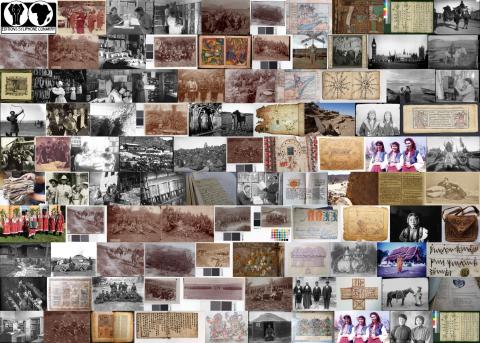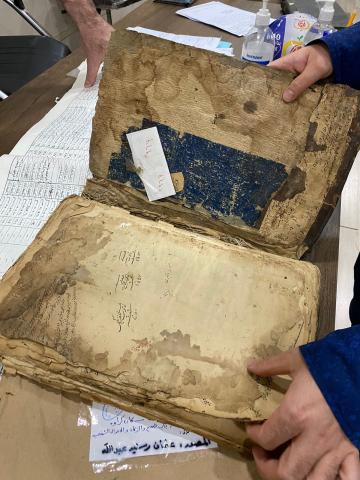
Aims and objectives
The objective of this project is to digitise and make widely accessible the full collection of manuscripts at the Franciscan monastery of St Saviour in the Old City of Jerusalem. The collection contains 553 codices and rotuli, dating from the 12th to the 20th century and written in eight languages: Arabic, Armenian, Ethiopic, Hebrew, Greek, Latin, Syriac and Turkish. A special group is made up by the decorated and illuminated manuscripts. The collection, due to its richness and diversity, presents great scholarly interest. The project will create approximately 140,000 pages.
The collection, due to its remarkable diversity, brings valuable research material for a large group of scholars interested in Christian, Islamic and Jewish traditions, and of importance for linguists and philologists, art historians, and musicologists. The collection is a storehouse of information for scholars interested in the archaeology and history of the Western and Eastern manuscript tradition.
The texts present great variety and contain theological and philosophical treatises, biblical and liturgical books, dictionaries, profane and religious poetry, collections of sermons, pilgrim accounts, and also cooking recipes and magic prayers. Among the books are also rare items, for instance texts written in Armenian and Arabic scripts but in Turkish language or the fragments of Byzantine manuscripts used for binding as the fly-leaves. A special group is made up by large size liturgical books with musical notations, produced for monastic choirs, as well as precious volumes lavishly decorated and illuminated with miniatures, initials and aniconic ornamentation. Research material of particular value consists of a variety of book covers (leather, textile, metal, decorative cardboards etc) representing diverse binding methods. As the whole, the collection presents a remarkably wide spectrum of Western and Eastern manuscript traditions: Christian, Islamic and Jewish.
The particular character of the collection makes this digitisation a challenging task (particular problems arise at the photographing of huge size volumes and books illuminated in gold and silver) but the team of the applicant is well experienced and accustomed to work with difficult manuscripts.
The digital collections will be deposited with the Biblioteca della Custodia di Terra Sancta in Gerusalemme at St Saviour; the British Library; the Centro di Ricerca Europeo Libro Editoria Biblioteca, Milano, Università Cattolica; The Instituto Biblico del’Ateneo Antoniano, Roma; the Centre of Christian Oriental Studies, Cairo, Muski Monastery (library partner for BCTSG); and the Library of the Higher Franciscan Seminary in Kraków (Poland).
Outcomes
The project included three digitisation sessions lasting 11 full weeks in total and the following was completed:
- The whole collection was researched, reorganised and relocated.
- Several new manuscripts have been discovered and included to the collection.
- The manuscripts in particularly bad physical condition and excluded from digitisation are safe-guarded in special boxes.
- Prior to digitisation the conservator made small repairs to several manuscripts.
- Since the collection turned out to be much more extensive than anticipated in the project´s application, the selection of the manuscripts for digitisation within the reported project was done in agreement with the director of the library according to the following criteria: the oldest books (12th-15th centuries), the manuscripts containing rare texts and musical notation, the books in particular need of conservation, the illuminated and decorated manuscripts (including the examples sent to the exhibition Jerusalem 1000-1400: Every People Under Heaven at the Metropolitan Museum, New York) and the manuscripts of particular interests for the specialists dealing with codicology and book history.
- During the final stage of the project, the whole photographic material was reviewed, checked and organised. It was divided into 743 folders and contains 135769 TIFF-files and 1766 NEF/JPG files (close-ups and microscope photos) - totalling over 4 TB.
- The metadata for each volume was entered into the listing template. The mistakes in the old catalogues have been corrected and new information added, namely: the titles in original languages along with English translations, number of folios/pages, dimensions of the books, custodial history of the manuscripts, names of the scribes, painters, donors and owners. Several new manuscripts became identified and supplied with appropriated catalogue data. It was also established that the manuscripts in the collection are noted not in eight but 17 languages: Amharic, Arabic, Armenian, Classical Ethiopic, Coptic (Bohairic & Sahidic), English, French, Old German, Greek, Hebrew, Italian, Latin, Samaritan, Spanish, Syriac and Turkish.
The records copied by this project have been catalogued as:
- EAP823/1 Manuscript Collection at Monastery of St Saviour in Old Jerusalem (1510-1999)
Due to the cyber-attack on the British Library in October 2023, the archives and manuscripts database is currently inaccessible and we are unable to provide links to the catalogue records for this project.



